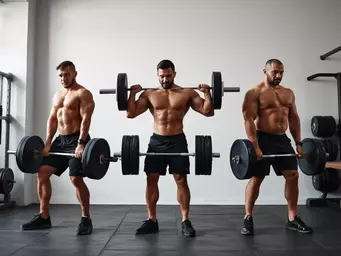
Effective Exercises for Glute Growth
To cultivate well-rounded strength and improve overall fitness, recognizing the importance of glute training is essential. How can you harness the power of your glutes to enhance both your performance and aesthetics? Dive in to uncover the key strategies that will elevate your workout!
What You Will Learn
- The glutes are the largest muscles in the body, crucial for enhancing athletic performance and stability.
- Progressive overload is key to glute hypertrophy; increasing resistance helps stimulate muscle growth.
- Proper nutrition, including proteins, carbohydrates, and healthy fats, significantly aids muscle recovery.
- Incorporating active recovery techniques, like yoga and foam rolling, can enhance flexibility and prevent soreness.
- Tracking progress through journals or fitness apps helps maintain motivation and adjust routines effectively.
- Reassessing your training program periodically ensures continued progress and engagement in your fitness journey.
Key Factors for Glute Growth and Recovery
Understanding the interplay between strength training, recovery, and progress tracking is crucial for optimal glute development. The visual below highlights the core elements involved.
Strength Training for Glute Hypertrophy
- ✓ Progressive Overload
- ✓ Muscle Fiber Tears & Repair
- ✓ Consistency is Key
Enhancing Recovery for Optimal Growth
- ✓ Balanced Nutrition (Protein, Carbs, Fats)
- ✓ Active Recovery & Mobility
- ✓ Minimize Muscle Soreness (Therapy)
Tracking Progress & Adjusting Training
- ✓ Workout Journal & Photos
- ✓ Monitor Strength Gains (Max Lifts, Measurements)
- ✓ Reassess Program Regularly
Gluteus Maximus: Role in Body Composition
- ✓ Improves Posture & Lower Back Health
- ✓ Enhances Athletic Performance & Power
- ✓ Aids in Calorie Burn (Resting)
Understanding Glute Growth and Strength Training
When it comes to fitness, many people often overlook the importance of targeting their glutes in strength training. But let me tell you, focusing on your glutes can make a huge difference not only in your physique but also in your overall performance! Understanding how glute growth works can help you design more effective workouts that truly enhance your strength and appearance.
At Exercises for Butt, we believe that glute training is essential for everyone, whether you're a beginner or a seasoned athlete. By incorporating focused glute exercises into your routine, you're not just working on your backside but also improving your core stability and lower body strength.
The Importance of Targeting the Glutes in Strength Training
Your glutes are the largest muscles in your body, and they play a critical role in various movements, from walking and running to lifting heavy weights. Targeting your glutes during strength training can significantly improve overall athletic performance and reduce the risk of injuries, particularly in the lower back and knees. The Journal of Clinical Rehabilitation Research highlights the importance of strong glutes for hip stability and mobility.
These benefits highlight just how crucial it is to incorporate glute exercises into your workouts. When your glutes are strong, you’ll find it easier to perform compound movements like squats and deadlifts effectively!

How Strength Training Stimulates Glute Hypertrophy
Glute hypertrophy, or muscle growth, occurs when you challenge your glute muscles through resistance training. According to the National Strength and Conditioning Association (NSCA), when you lift weights or perform bodyweight exercises, tiny tears form in your muscle fibers. As your body repairs these tears, your muscles grow back stronger and larger.
This is why progressive overload is essential in any strength training program. Gradually increasing the weight, reps, or intensity of your glute workouts encourages your muscles to adapt and grow. Remember, consistency is key to achieving those coveted glute gains!
The Role of Gluteus Maximus in Overall Body Composition
The gluteus maximus is the powerhouse of your posterior chain, and its strength plays a vital role in your overall body composition. A strong gluteus maximus contributes to better posture, improved strength in your legs, and enhanced athletic performance.
Additionally, having well-developed glutes can help you burn more calories while at rest! This means that as you strengthen your glutes, you're also working towards a healthier body composition. Here are some more reasons to prioritize your glute training:
- Supports lower back health
- Aids in greater power during athletic activities
- Improves balance and coordination
So, don’t underestimate the impact of your glute workouts! They are fundamental not just for aesthetics but for overall fitness and health.
Pro Tip
To take your glute training to the next level, consider adding resistance bands to your exercises. These bands are fantastic for increasing glute activation during movements like squats and glute bridges. Simply place the band just above your knees, and you'll immediately feel the difference!
Enhancing Recovery for Optimal Glute Growth
To maximize your glute growth, it’s essential to focus on effective recovery methods. Recovery isn’t just about resting; it’s a crucial part of your fitness journey! By enhancing recovery, you allow your muscles to repair and grow stronger after those intense workouts. Here are some key strategies to help boost your recovery efforts:
- Prioritize adequate nutrition
- Incorporate active recovery days
- Utilize effective recovery techniques
Nutritional Considerations for Supporting Muscle Recovery
What you eat plays a major role in your recovery process! As a fitness enthusiast, I can’t stress enough how important it is to fuel your body properly. Consuming a balanced diet rich in proteins, healthy fats, and carbohydrates can significantly aid in muscle recovery:
- Protein: Helps repair and build muscle fibers. Foods like chicken, tofu, and legumes are excellent sources.
- Carbohydrates: Replenish glycogen stores depleted during workouts. Think whole grains and fruits!
- Healthy Fats: Support overall health and reduce inflammation. Avocados and nuts are fantastic options.
Combining these nutrients in your post-workout meals can enhance your recovery and support glute growth. Remember, hydration is equally important, so drink plenty of water!

Incorporating Active Recovery and Mobility Work
Active recovery is a game-changer! Instead of completely resting, engaging in low-intensity activities helps keep your blood flowing and muscles loose. Here are some effective active recovery activities you might consider:
- Walking or light jogging
- Yoga or stretching sessions
- Foam rolling for muscle tension relief
Focusing on mobility work can also improve your range of motion and prevent stiffness. Spending just a few minutes on these activities can make a significant difference in your overall performance.
Recovery Techniques to Minimize Muscle Soreness
Feeling sore after a tough workout? It’s totally normal! However, there are several techniques I use to minimize muscle soreness:
- Cold therapy, like ice packs or cold showers, can reduce inflammation.
- Heat therapy, such as warm baths, helps relax tight muscles.
- Massage therapy can aid in reducing muscle tension and promote circulation.
Experiment with these techniques to find what works best for your body. Remember, listening to your body is key, especially after intense glute workouts!
Tracking Progress and Adjusting Your Glute Training
Progress doesn’t come overnight, but tracking it can help keep you motivated! At Exercises for Butt, we believe that monitoring your improvements is crucial for staying on track with your glute training. Let’s dive into effective methods for tracking progress:
- Keep a workout journal to note your exercises and reps.
- Take progress photos to visually see changes over time.
- Use fitness apps or trackers to monitor your strength gains.
Methods for Monitoring Strength Gains and Muscle Growth
How do you know if your glute training is effective? Here are some methods to monitor your gains:
- Regularly test your maximum lifts to gauge strength increases.
- Track your measurements; increased glute size is a great indicator of growth!
- Note any improvements in endurance or performance during workouts.
Consistent monitoring keeps you informed and motivated, allowing you to adjust your routine as needed.
When to Reassess Your Training Program for Continued Progress
It’s important to reassess your training program regularly! Here are some signs that it may be time for an adjustment:
- You’ve stopped seeing progress in strength or muscle growth.
- Your workouts feel too easy and lack challenge.
- You’re not enjoying your current routine anymore.
These signals can help you determine when to tweak your program. Remember, variety is the spice of life—and fitness!
Using Fitness Tracking to Optimize Your Workout Regimen
Fitness trackers can be incredibly useful tools in your arsenal! They allow you to monitor your activity levels, track your workouts, and even keep tabs on your nutrition. Here are some benefits of using fitness tracking:
- Set specific goals and track your progress toward them.
- Receive reminders to stay active and engaged in your workouts.
- Analyze your sleep patterns, which is crucial for recovery.
By integrating fitness tracking into your routine, you can gain valuable insights that help you make informed decisions about your glute training journey!
Final Thoughts on Building Stronger Glutes
Building stronger glutes takes time, dedication, and the right strategies! At Exercises for Butt, we’re committed to helping you implement science-backed approaches for effective glute training. The American Council on Exercise (ACE Fitness) provides further insights into evidence-based approaches for glute training. Here are some final tips:
- Stay consistent with your workouts and recovery.
- Educate yourself continuously to enhance your understanding.
- Seek support from personal trainers or online resources for guidance.
With the right mindset and tools, you can achieve your fitness goals and experience the confidence that comes with a stronger backside!
Frequently Asked Questions (FAQs)
- Q: Why is glute training important?
- A: Glute training is essential for overall strength, athletic performance, hip stability, and reducing the risk of lower back and knee injuries. Strong glutes also contribute to better posture and help burn more calories at rest.
- Q: What is glute hypertrophy and how is it achieved?
- A: Glute hypertrophy refers to the growth of glute muscles. It's achieved through resistance training that creates tiny tears in muscle fibers, which then repair and grow back stronger. Progressive overload (gradually increasing weight, reps, or intensity) is crucial for this process.
- Q: What role does nutrition play in glute growth and recovery?
- A: Proper nutrition is vital for muscle recovery and growth. A balanced diet rich in proteins helps repair muscle fibers, carbohydrates replenish energy stores, and healthy fats reduce inflammation and support overall health. Hydration is also key.
- Q: What are active recovery and mobility work?
- A: Active recovery involves low-intensity activities like walking, light jogging, or yoga that help maintain blood flow and muscle flexibility without overstressing the body. Mobility work focuses on improving range of motion and preventing stiffness.
- Q: How can I track my glute training progress?
- A: You can track your progress by keeping a workout journal, taking progress photos, monitoring your maximum lifts, measuring glute size, and noting improvements in endurance. Fitness apps and trackers can also provide valuable insights into your regimen.
Recap of Key Points
Here is a quick recap of the important points discussed in the article:
- Targeting your glutes can significantly improve athletic performance and reduce injury risks.
- Progressive overload is essential for stimulating glute hypertrophy, leading to muscle growth.
- Proper nutrition, including protein and carbohydrates, is crucial for effective recovery and muscle repair.
- Incorporating active recovery and mobility work can enhance recovery and performance.
- Tracking your progress through measurements and workout journals can help you stay motivated and make necessary adjustments.
- Regularly reassess your training program to ensure continued progress and enjoyment in your workouts.





Glute-Focused Deadlift Variations Explained
Boost Your Glute Activation Today
Dumbbell Moves for Stronger Glutes
Hip Thrusts or Squats: Choose Wisely
Glute Activation Moves Before Workouts